Sustainable Mobility Partner
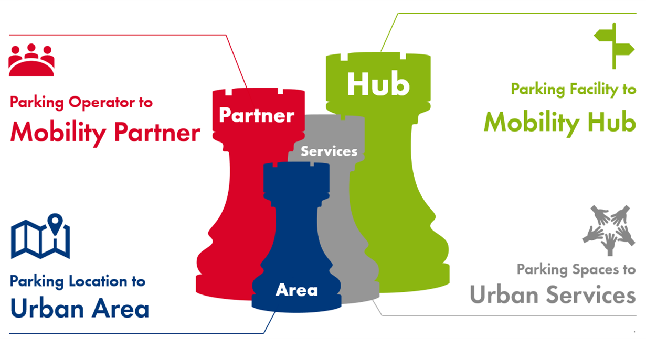
Prompted by the European Union’s Green Deal and national government directives, many metropolitan areas and cities have adopted a sustainability agenda. The vision and plans set out encompass a wide range of environmental targets.
Multi-disciplinary teams, representing the multiple policy areas involved, are working to translate the new agenda into sustainable urban mobility plans (SUMPs). The aim is to move towards future-proof sustainable and more user-centric urban mobility for the convenience of residents, commuters and visitors alike.
In the long run, sustainable urban mobility will benefit the entire community as infrastructure is improved and movements in and around cities become more efficient. The knock-on effects, including more active mobility, lower emissions and greener urban areas, will also benefit public health and welfare.
Having analysed over one hundred city specific sustainable urban mobility plans in various countries, Q-Park’s sustainable mobility experts have noticed a trend to set targets and draw up plans that:
reduce emissions and pollution;
create accessible and liveable urban areas;
free up public space for people and greenery;
increase vitality as more people engage in active mobility and walk or cycle to their destination.
Key shift in sustainability agenda
Throughout Europe, there’s a shift in the sustainability agenda. Personal mobility remains an important economic driver. However, as the need for sustainable mobility increases, the focus is now shifting:
from cars to people (Space & Greenery);
from cars to active mobility (Walking & Cycling);
from owned to shared (Car sharing & Public Transport);
from fossil fuels to electricity (EV Cars & EV Logistics)
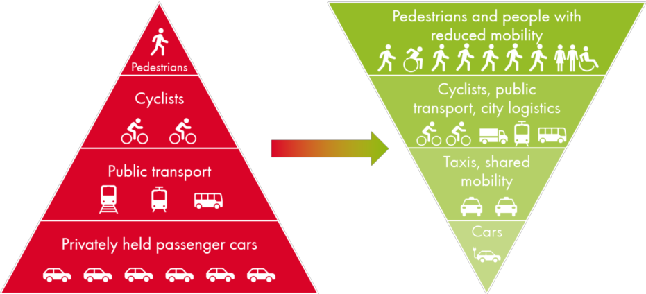
Key shift in metropolitan mobility agenda
Mobility hubs are the solution
When you, as urban mobility planner, step back and take a wider perspective on mobility, you may start to consider mobility and transport in urban areas as a whole. Rather than planning and making provisions for the different modes of public and private transport separately, it makes sense to combine them – city wide!
As you consider the network of bus and tram stops, light rail and train stations, you can identify local hubs that people walk or cycle to. When you add passenger cars into the mix, the network also includes public and private car parks.
Here, we see areas emerging where people switch from one mode of transport to another. They are defined as Mobility Hubs. These are places where travellers switch between various modes of transport:
mass transit: train, tram, metro, bus
private modes: taxis, shared or owned cars, bicycles
active mobility: cycling or walking
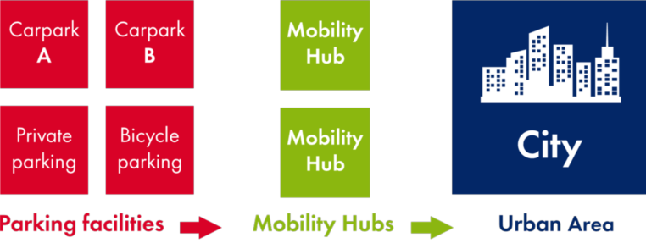
Mobility hubs are the solution
When transport nodes converge, they form a hub. For example, a bus stop is probably the smallest local hub. Travellers walk or cycle to the bus stop, then travel to the next hub in the hierarchy, a train station for instance, where more modes of transport going in multiple directions are available. Car owners may drive to a train station and will need to park there before proceeding their journey.
When you combine a network of car parks with a variety of mobility options at multiple locations in the wider metropolitan area, you facilitate individual and sustainable mobility. Catering to specific needs of residents, commuters and visitors.
Mobility hubs serve a higher purpose
When the right mix of transport and facilities are brought together, a hub can contribute to reducing the percentage of distance travelled in private cars and increase the distance covered using public transport and active mobility.
When mobility hubs are strategically placed at the city ring, they contribute to inner-city carbon footprint reduction, cleaner air, less noise and better opportunities for moving around in liveable and economic centres. Encouraging motorists to leave their cars at the hub creates space in the city centre for more green areas, better public transport and good conditions for cyclists and pedestrians.
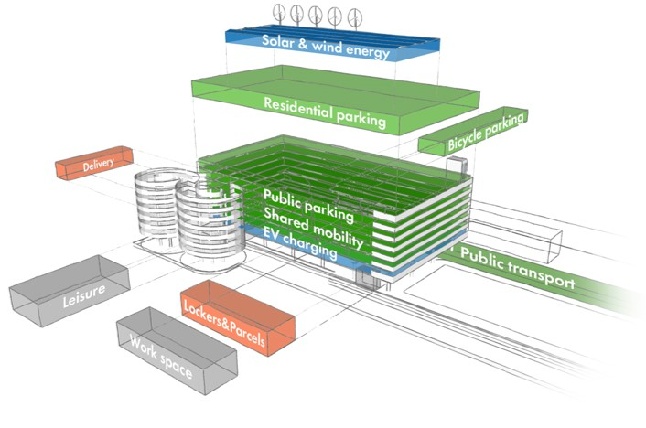
Mobility hub concept - above ground
Services can be added to expand hub functionality:
Mobility: In addition to car parking, for residents, commuters and visitors, a mobility hub provides access to public transport, bicycle parking and shared mobility.
Activity: Hubs are activity zones. They offer space for retail and services, for meeting and working, and also form an ideal location for events and leisure amenities.
Delivery: Goods can be delivered by larger, long-distance vehicles. A hub offers a location for cross-docking goods so these can be transported by smaller, preferably electric vehicles into the city.
Energy: Power supply is under pressure due to the increase in electricity consumption. It makes sense for a hub to generate its own power and store generated electricity for later consumption, for example for charging electric vehicles and e-bikes.
Urban mobility is complex
Q-Park understands the dilemmas you face. There are many players involved. You seek an equilibrium between the needs of residents, commuters and visitors and the economic function in the urban area.
You want to increase liveability in your metropolitan area by:
creating public space for bicycles and pedestrians;
encouraging electric and shared mobility;
facilitating transition between modes of transport;
regulating access to the inner city;
managing urban logistics.
While at the same time, you want to:
discourage car use in the denser urban areas;
reduce search traffic in the inner city;
limit on-street parking;
reduce truck, van and delivery traffic;
reduce air pollution.
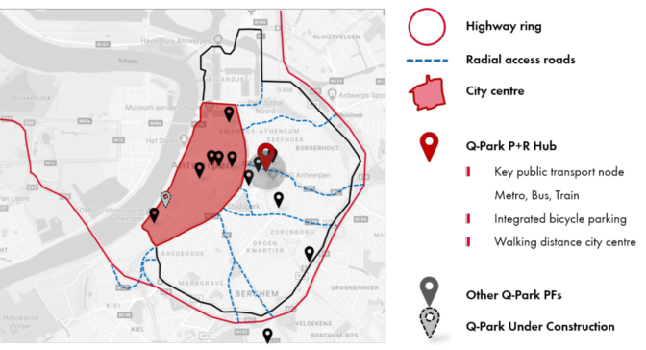
Urban mobility partnership perspective - city wide
Q-Park is your sustainable mobility partner
As your mobility partner, Q-Park can help get your plans moving in the right direction and keep you on track. We have considerable knowledge and experience to guide you. Together, we will look for ways to make sustainable mobility successful. Measures we can help you introduce include:
transitioning from on-street to off-street parking;
transforming search traffic to destination traffic with smart navigation and pre-booking;
facilitating EV charging and shared mobility;
offering logistics services, at the edge of the city and at the boundaries of low- and zero-emission zones.
Four reasons for partnering with Q-Park:
sustainable mobility partner, not just a car park operator
off-street urban services, not just parking spaces
urban area perspective, not just single car park solutions
fully functioning mobility hub portfolio, not just talk
Q-Park is more than a car park operator, Q-Park moves you and your sustainable urban mobility plan (SUMP) forward.
Proven experience in energy-neutral parking
Q-Park has been instrumental in realising sustainable urban mobility hubs in various cities throughout Europe. We collaborate with urban mobility experts and contribute our knowledge and expertise to initiatives that work towards achieving the European Union's Green Deal objectives.
Together with municipal planning experts, we have built and transformed parking facilities into sustainable multifunctional mobility hubs.

By incorporating PV panels and/or wind turbines to generate power and by installing low-energy LED lighting and energy storage, our mobility hubs are sustainable, low- or zero-emission parking facilities while providing green energy for EV charging.
For examples, see:
Smart parking capacity
Urban mobility is sustainable when the parking capacity available meets the needs of residents, commuters and visitors. These groups have different mobility needs and differing car parking requirements.

Q-Park has developed a parking capacity model that uses reference projects, car park occupancy data and KPI benchmarks to calculate the ideal parking capacity at a given location.

The Q-Park capacity modelling tool can help sustainable mobility planners calculate the ideal capacity of mobility hubs at various locations in the metropolitan area.
For more details of our approach, see smart data fosters smart developments.
